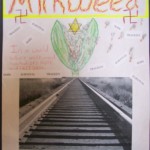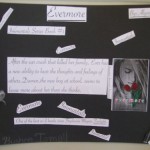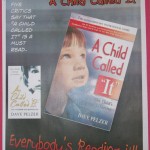"Art" of Persuasion
The Thousand Word Project (Rhythms and Motifs), Susan B. Weber, Lewiston Middle School, The “Art” of Persuation
Essential Questions:
What are the psychological effects of color, shape, and size in visual text?
How do these elements affect emotions (mood) and decision-making (persuasion)?
How can these fundamentals of art be used to create illusions?
How do advertisers employ these principles of design to promote their products?
Objectives:
To understand how artists use elements of design to produce specific effects.
To be able to create effective print advertisements by manipulating the elements of color, shape, and size.
Learning Results: Parameters for Essential Instruction:
A4e Identify purpose and intended audience of a [visual] text.
A4f Identify rhetorical devices an author [artist] uses to persuade the reader [viewer] including bandwagon, peer. pressure, repetition, testimonial, hyperbole, loaded words, transfer, amplification, and extended metaphor.
B1b Decide which information is included to achieve the desired purpose.
B4a Employ a variety of persuasive techniques…appropriate to the audience and purpose …intended to influence the opinions, beliefs, or position of others.
F1a Describe and evaluate the text features of visual and non-visual media.
F1b Explain the role of the media in shaping opinions.
F1c Note instances of bias, stereotyping, and propaganda.
Materials:
Slides of a variety of drawings and paintings from the Bates College Olin Arts collection, LCD projector, Print advertisements, Classroom materials, Laptops.
Bates Collaboration Lesson:
Presenter will introduce how the elements of color, shape, and size can be used by artists to create specific effects, including such intents as contrast, associations, moods, prominence, etc. Presenter will show slides of a variety of drawings and paintings which employ the aforementioned elements. Students will identify the elements within the pieces and discuss the effects they have on them, the viewers.
Literacy Lesson:
Instructor will introduce common propaganda techniques (as outlined in PEI A4f). In groups, students will categorize a collection of print ads according to the techniques used. Groups will then determine which previously taught art elements (color, shape, size) are evident in the ads and what impact they have. Students will then select a book they have read this year to advertise.. Incorporating at least two different propaganda techniques, students will design and draft ads for their book which effectively utilize the artist’s elements of color, size, and shape. Using technology or classroom art materials, students will produce three polished magazine ads to promote their chosen book.
Assessment:
Students will be able to identify and explain the propaganda techniques used in their ads and justify how they are effective in persuading the audience to purchase the book.
Students will be able to demonstrate an understanding of how the elements of art are used effectively in creating the desired advertising effect.
After you have finished using this TWP lesson with your students, please help us improve the program by responding to this short survey at https://bates.co1.qualtrics.com/SE/?SID=SV_2oikOibUWoOemsl


